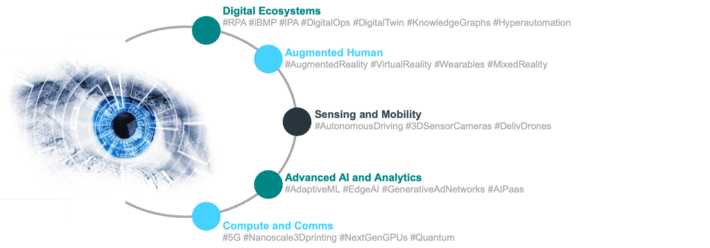
DigitalOps has been one of the emergent topics in 2019 (link) and will still be on the “hype curve” designed by Gartner for the next years, now in 2020 the buzz word is hyperautomation (link). DigitalOps means that all the digital transformation initiatives and investments over the last decade have pushed the enterprises to become digital organizations or get into digital markets where their management, businesses and operations processes now have to be handled with Data. That drives the Data-Driven companies to invest on bringing these DigitalOps processes as close as possible into their current Data and Analytics corporate platforms.
This cohesion enables the process automation tools to embed the Machine Learning and processing of your Data to become Intelligent Process Automation (IPA) Platforms which main purpose is to hyperautomate the organizations (now that they can). The latests investments are on these focal points that can summary the IPA ecosystems capabilities:
· Process Automation through Robotization and Artificial Intelligence: In the DigitalOps environments, BPMs and RPAs are representing the two-speeds of the IT organizations. BPM solutions are handling the business processes in an enterprise, secured, governed and compliant way. BPM areas are growing every year at Cruise speed (Speed 1) by keeping allignment between IT and their lines of Businesses. At the same time (but at Speed 2) business users are using RPA tooling in a faster way, replicating the human behaviors, automating processes and getting ROI rapidly withoug taking care of standard enteprise methodologies. This is leaving behind technical debt that the Cruise eventually has to take care to support the overall automation at enterprise level in a sustainable way. Both BPM and RPA are now supporting together the Digitalops processes and both are evolving to embed artificial intelligence solutions on their workflows in order to handle, to process and to support the unstrutured Data (Voice, Image, Video, Text), to utilize text-heavy capabilities, to recommend or to make decisions based on hypothesis, and to learn over time on the different feedbacks/interactions they get.
· Digital and Instant Customer interactions: in the dynamic digital Market we are, the instant interactions are key to support the customer experience and keep the processes efficient. The development of autonomous cognitive things (agents, robots, chatbots,…) on these platforms become crucial to Interact with employees, customers and even other things. These things need to use different Knowledge domains: from the customer datawarehouse, from the actual process, from the latest interactions and need to have specific Natural language processing, understanding and generation (NLP, NLU and NLG) in order to respond with answers, decisions or derive to human with recommended next actions instantly and seamlessly with the customer in front.
· Structured and Non-Structured Datawarehouse Management: digital means data, and in the DigitalOps the data is gathered as input, used in the process, computed in some way and sent as an output. All the process lifecycle metadata is also rich and needs to be stored with the rest of the rich information about the process, customer or enterprise management. These datastore is used by the AI Engines trainings, and where the cognitive agents store their interactions. Having a central repository of information is the foundation for the process automation with intelligence and are a core of the IPA platforms, unless you want to run your DigitalOps with only others’ data and engines and therefore not get any specific personalized experience.
· Real-time consumption of Analytical AI Engines: wether these are based on Rules, Machine Learning, Deep Learning or deeper Cognitive complex mix of algorithms, the AI engines are used to create the AI Capabilities of the IPA platforms: Unstructured Data processing, Natural Language Processing, Understanding, Generation, Recommendation on the specific context scenarios,… The capabilities are used by the AI Agents or directly by the IPA Workflows through Corporate APIs and have the skill to learn over time (by retraining or by reward-reinforcement learning), or take learnings from other capabilities (by transfer learning). Apart from the internal AI capabiltiies that are trained with organizations data, IPA workflows might be using external APIs so can leverage the innovation of big players in the AI marketplace.
With these IPA layers working together, automation solutions can be like these examples: Robots can mimick the clicks, forms registration and sharing all the information from customer Datawarehouses (RPA), interacting and interpreting complex text communications in specific personalized context (Natural Language Processing, Understanding and Generation — NLP, NLU NLG), applying knowledge based learning rules decisions that were not programmed specifically (Machine Learning), Processing documents that customer is sending or doing face recognition (Deep Learning) and making recommendations to customers or augmenting employees (AI Agents).
To finalize, the landscape of process automation is now leveraging AI and corporate Data and Analytics Platforms and during this year that will be gradually covering the DigitalOps processes and improving the Operational Efficiency, Customer Satisfaction and Scalability of the Organizations.
As a vision for the future: In the long-term, by covering all the business digitally (as a Digital Twin) this might be evolving into Hyperautomated Organizations (in terms of volume and capabilities) and this maximum hyperautomation would mean that we might have Autonomous organizations, where all the processes would be automated and naturally evolving with the market.
Now your turn, when do you think we will have a first Autonomous organization? In which industry? Comment here and see where it goes!



